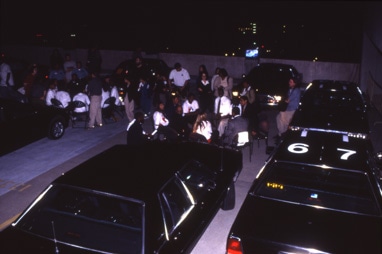A criminal conviction can also subject an individual to myriad other punishments that are not strictly collateral consequences. Hidden sanctions can appear in the form of fees owed to the state arising from imprisonment, 1 including payment for the cost of probation, parole and restitution, debt garnishment such as child support arrears, and other counterproductive sanctions like automatic suspension of driver’s licenses for any drug conviction. Such barriers make it difficult for people to stay out of the criminal justice system after release. The vast majority of prisoners will come home eventually, but recidivism rates are high: of those leaving prison, nearly two-thirds will return within three years. 2
There is an inescapable nexus between entrenched poverty, the criminal justice system, and the sanctions that ultimately punish people simply because they are poor. One aspect of these civil disabilities should be of particular interest to anti-poverty advocates. Collateral sanctions—particularly against people with drug convictions—have an impact on poor people almost exclusively. Prisoners are overwhelmingly low-income, 3 but collateral sanctions deprive formerly incarcerated people of opportunities to lift themselves out of poverty. These same sanctions applied against those with financial and social resources will have a negligible impact. Consider just a few of the collateral consequences that have an effect on the areas of life most necessary to stabilize after a prison or jail sentence:
- Formerly incarcerated people are likely to find employment, if at all, in the low-wage economy. This is based on the level of work-related skills and education that the majority of them possess. Without the social connections available to people with more resources, returnees have a diminished ability to create opportunities less dependent on the wage economy. Therefore, they are far more negatively affected by the vast array of general restrictions on jobs (and even occupational licenses) for people with criminal records.
- Next to meaningful employment, secure housing is critical for successful reintegration. Most housing prohibitions for people with criminal records are directed against those seeking federally subsidized housing, and these are among the poorest of Americans. Further, the same housing restrictions prevent formerly incarcerated people from living with family members in public housing who will be at risk of eviction if they reside with them, even temporarily.
- Bans on public benefits, which in some states are total if you are convicted of a drug crime, preclude those who are poor and substance-addicted from obtaining meaningful drug treatment and recovery, since they are not able to pay for private rehabilitation centers that require health insurance.
Civil legal barriers create more restricted access to social support for low-income people with criminal records, and sometimes foreclose access entirely. Formerly incarcerated individuals arguably need social services and subsidies the most, owing to the lack of access to education, employment opportunities, and substance abuse treatment typically reported before entering the criminal justice system. 4 The rhetoric of redemption and, specifically, reentry suggests that those who have “paid their debt to society” deserve a second chance to make things right and live, if they choose, as law-abiding citizens. For many low-income people, civil legal barriers, in addition to conviction-related stigma, make the promise of a new life an empty one.
The unprecedented number of people currently in prison, on probation or parole, or simply saddled with a criminal record means that incarceration is an issue that anti-poverty advocates must address if they are to develop any effective strategies to engender economic justice. Rethinking crime strategies may allow for specifically exploring the possibilities of restitution and “restorative justice,” rather than simply locking up offenders. 5 This might serve to strengthen and protect poor communities more comprehensively in the long run. Aggressive jailing, without more, does nothing to rebuild communities damaged by violence and the effects of incarceration. Consequently, anti-poverty activists and scholars must begin to incorporate a different paradigm to address incarceration as both a consequence of poverty and a co-recurring factor in a vast majority of low-income communities 6 in the United States.
- Cammett, Costs, supra note 11, at 318; see also Rachel L. McLEan and Michael D. Thompson, Repaying Depts, Council of State Governments Justice Center (2007), http://tools.reentrypolicy.org/repaying_debts.[↑]
- Travis et al., supra note 13, at 1.[↑]
- Id. at 9; In 1999, public defenders handled 82% of the 4.2 million cases in the largest 100 counties in the U.S. See Office of Justice Programs, Bureau of Justice Statistics, U.S. Department of Justice, Indigent Defense Statistics, http://www.ojp.gov/bjs/id.htm#findings.[↑]
- Travis et al., supra note 13, at 9.[↑]
- But see e.g. Richard Delgado, Prosecuting Violence: A Colloquy on Race, Community, and Justice, 52 STAN. L. REV. 751 (2000) (comparative analysis of restorative justice principles and the traditional criminal justice system that includes critiques of both). “Restorative Justice advocates argue that incarceration offers little in the way of rehabilitative opportunities for offenders. Many emerge from prison more hardened and angry than when they entered, setting up a cycle of recidivism that serves neither them nor society. Moreover, although the victims’ rights movement has begun to clamor for restitution as a part of court-ordered sentencing, relatively few victims receive compensation for their injuries, and fewer still receive anything resembling an apology from the perpetrator.”[↑]
- See e.g. Todd R. Clear, Backfire: How Mass Incarceration Makes Disadvantages Communities Worse (2007); see also Dorothy E. Roberts, The Social and Moral Cost of Mass Incarceration in African American Communities, 56 STAN. L. REV. 1271, 1281 (2004) (examining theories of community harm and evidence of mounting harm to African American communities due to incarceration).[↑]



